How to Connect Android Phone to Mac: The Best Methods
Macs are fairly user-friendly, but even experienced users may find it difficult to use any Apple device in conjunction with an Android phone or tablet. There are a lot of reasons why you might need to connect your device to your Mac: file transfers to and from your Android, device backups, and even just easier file perusal all come to mind – so finding the right software is key. Fortunately, you have quite a few convenient options at your disposal. Keep reading for our top picks for the best tools.
Mac and Android Connectivity Issues
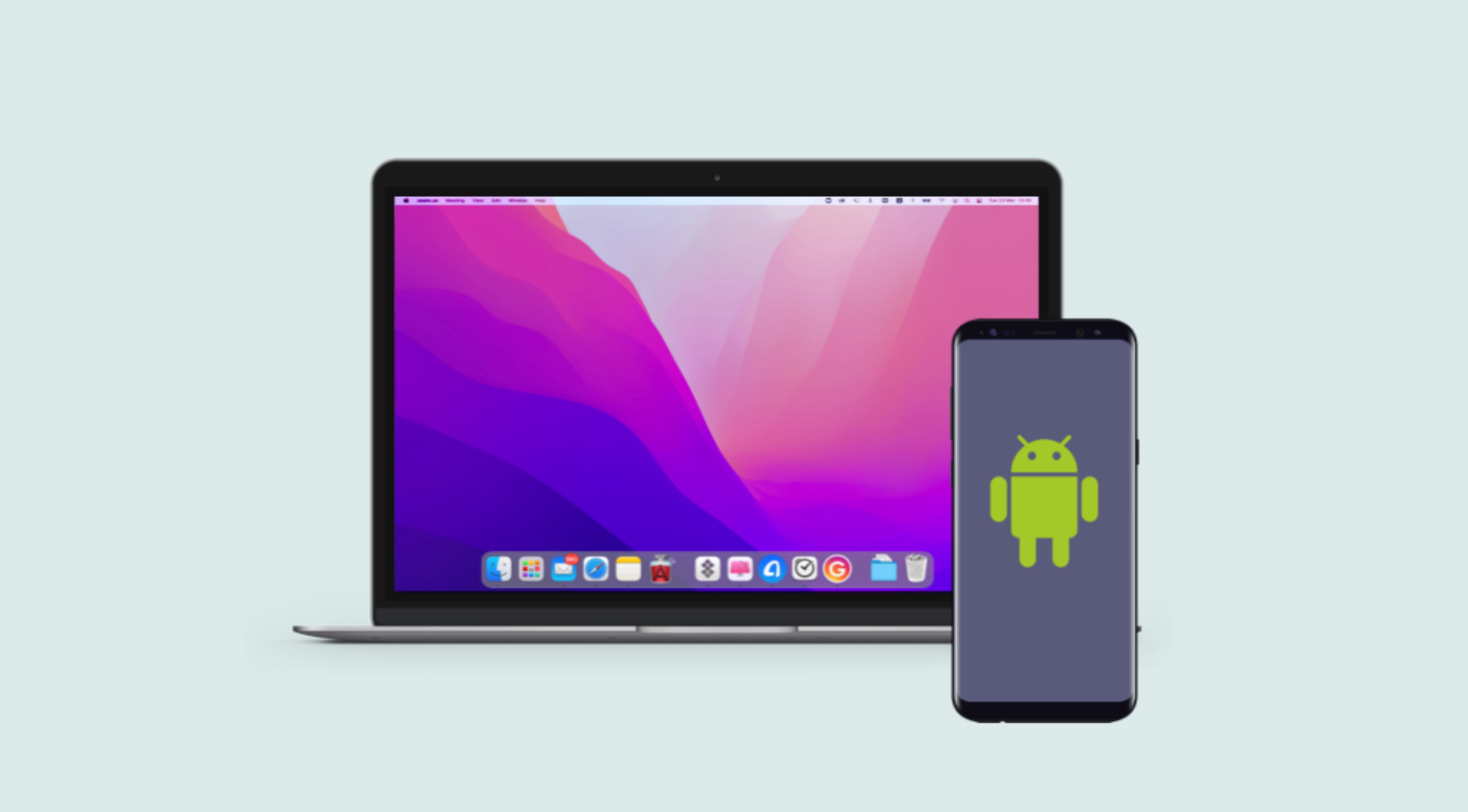
Unsurprisingly, there is no native way to connect Android to Mac and then browse; macOS doesn’t support mounting your Android as a drive as a default option. For this exact reason, plenty of third-party apps that help bridge the gap between your devices with different OS. While most have their fair shares of pros and cons, all will accomplish the basic goal of allowing you to view your phone’s contents on your Mac, whatever brand of android phone they have – Samsung, Motorola, Google, Google Pixel, HTC, Xiaomi, Huawei, LG and others. We’ll walk you through the best ways to mount Android devices to Mac and how to use them most effectively.
Connect Android Phone to Mac using Third-Party Apps
Transfer Data Between Mac and Android Using Android File Transfer
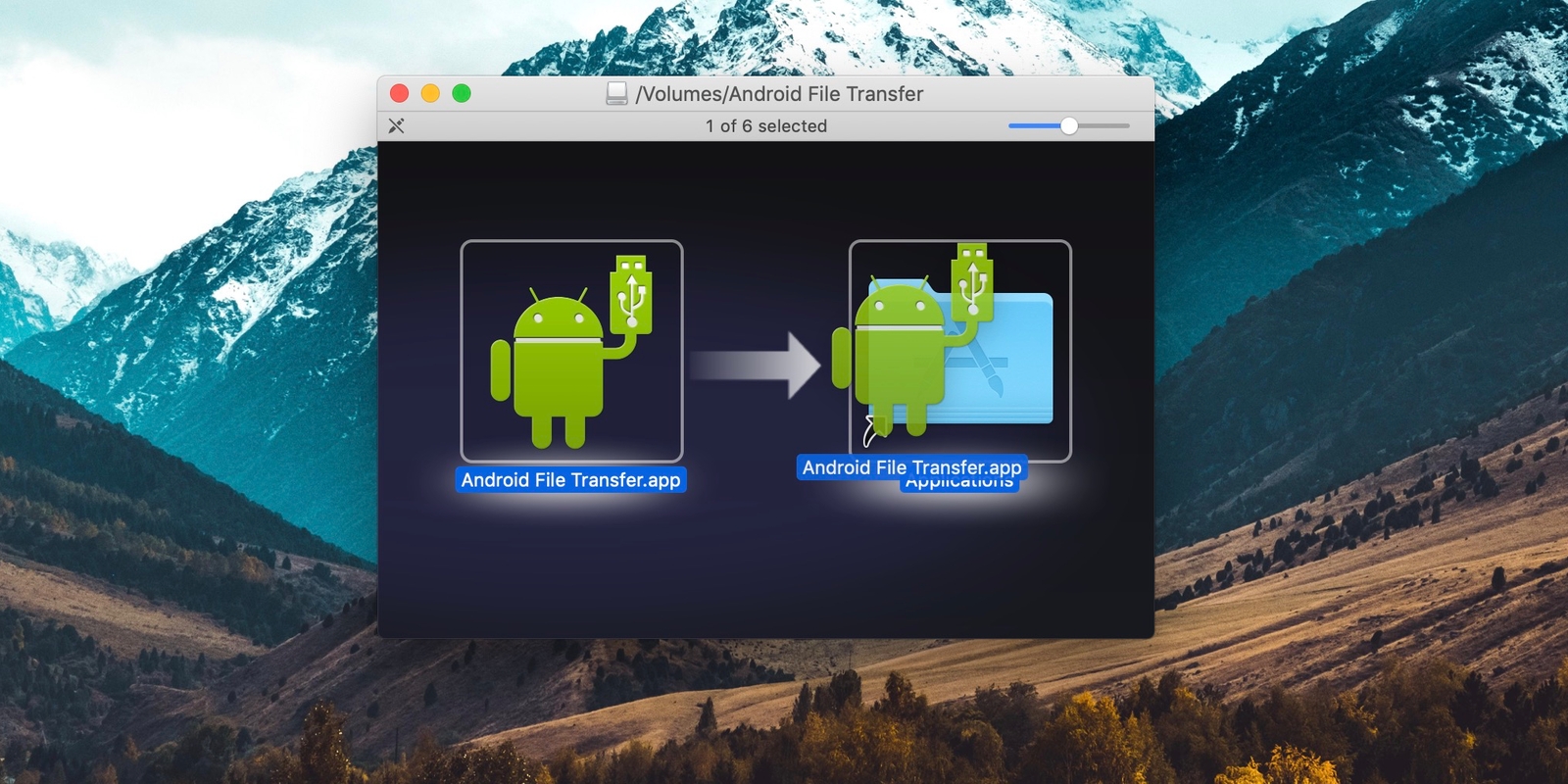
Android File Transfer (AFT) is perhaps the best-known interface app for Android users worldwide. Not only is it entirely free to use, it also benefits from timely updates that ostensibly help it bridge the gap between both updated devices, making it both secure and convenient to send files from and add files to your Android, that is, when it works correctly.
Since AFT is made and supported by Google, you’re likely to run into operational errors and connection problems from time to time, such as a failure to recognize your phone. If your Android won’t connect to Mac with this method, keep in mind that most of these errors can be fixed with the classic “unplug and replug” method, but AFT will probably never work 100 percent of the time on your Mac. That said, here is how you can use Android File Transfer:
- Download the app and install it via the DMG file.
- Open AFT on your Mac.
- Connect your Android phone or tablet to your Mac via the included USB cable.
- Follow the on-screen prompts to open your Android, then browse as needed.
Once you have installed Android File Transfer, you should be able to move files to and from your Android as long as the latter is connected to your Mac.
- Official app from Google
- Completely free
- Easy to navigate and transfer files
- Lacks advanced features
- Only works with a wired USB connection
- Some users report connection drops, slow data speeds and difficulty recognizing devices
Conclusion
It’s clear that AFT isn’t perfect, and you’re sure to run into some errors here and there when using it on Apple devices. However, given that it is free software that is still supported by the developer, it is a robust and understandably popular option for anyone who has wondered how to connect Android phone to Mac.
- macOS
- Windows
- iOS
- Android
- Free
MacDroid – The Easiest Way to Сonnect Android to Mac
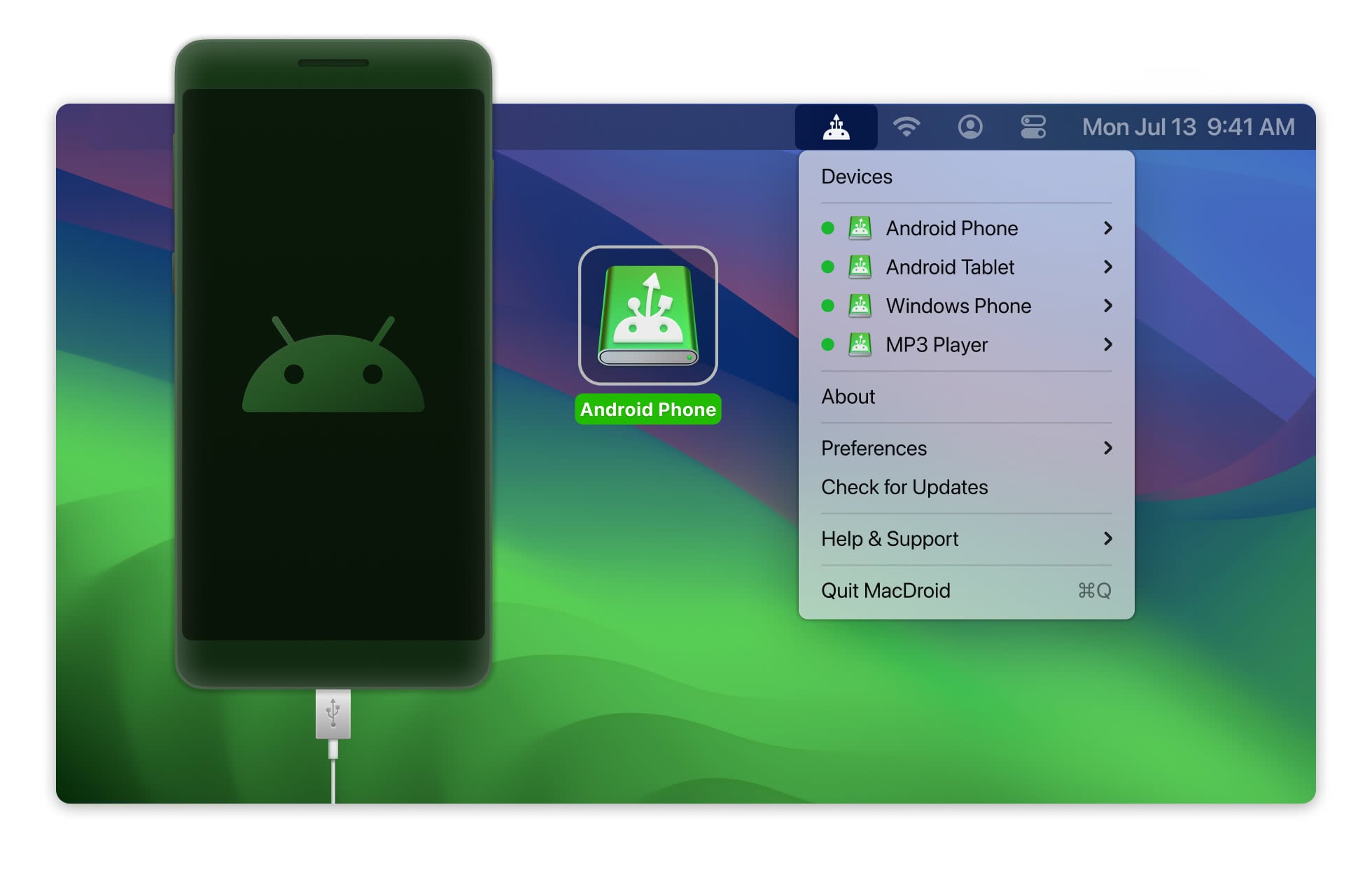
If you’re looking for a more reliable interface option when connecting your Android to your laptop, look no further than MacDroid. MacDroid has a lot going for it as the macOS-compatible file transfer app, but you’ll also find that it offers a ton of different options for interacting with and moving the files on your Android. It has support for two different file transfer protocols: the universally-renowned MTP as well as the faster, albeit advanced, ADB – which gives you flexibility in terms of your use of the app. Macdroid also offers a Wi-Fi connection mode that allows you to connect your devices wirelessly. Since MacDroid mounts your Android as a drive rather than simply opening its file management system, you can rest assured that you will always be able to connect your Android to your Mac with this app.
To use MacDroid, you’ll first need to download and install it on your Mac. Then, do the following:
- Attach your Android to your Mac using a USB cable or internet connection.
- Open MacDroid, then select the Devices option in the menu.
- When prompted, select either ADB or MTP mode. ADB is faster than MTP, but you will need to change settings to enable USB debugging
- on your Android if you want to use this option.
- Follow the on-screen prompts to mount and view your Android’s files.
- Has a simple interface that’s easy to navigate
- Works with a vast range of Android devices
- Supports, MTP, ADB, and Wi-Fi modes
- Mounts Android as a disk on a Mac
- Lets you edit files directly on your Android
- Not Windows OS compatible
- Restrictions in the free version
Conclusion
Clearly, using MacDroid to access Android from Mac is an easy and straightforward process. It’s definitely not a secret that the PRO version of MacDroid, which allows transfers from Mac to Android, is relatively pricey at $19.99 per year. However, it’s also important to note that the security that MacDroid offers is absolutely worth the price, whether you’re a power user or a casual proponent of backups.
- macOS
- Free
- $19.99 per year (PRO version)
Connect Android Device to Mac with OpenMTP
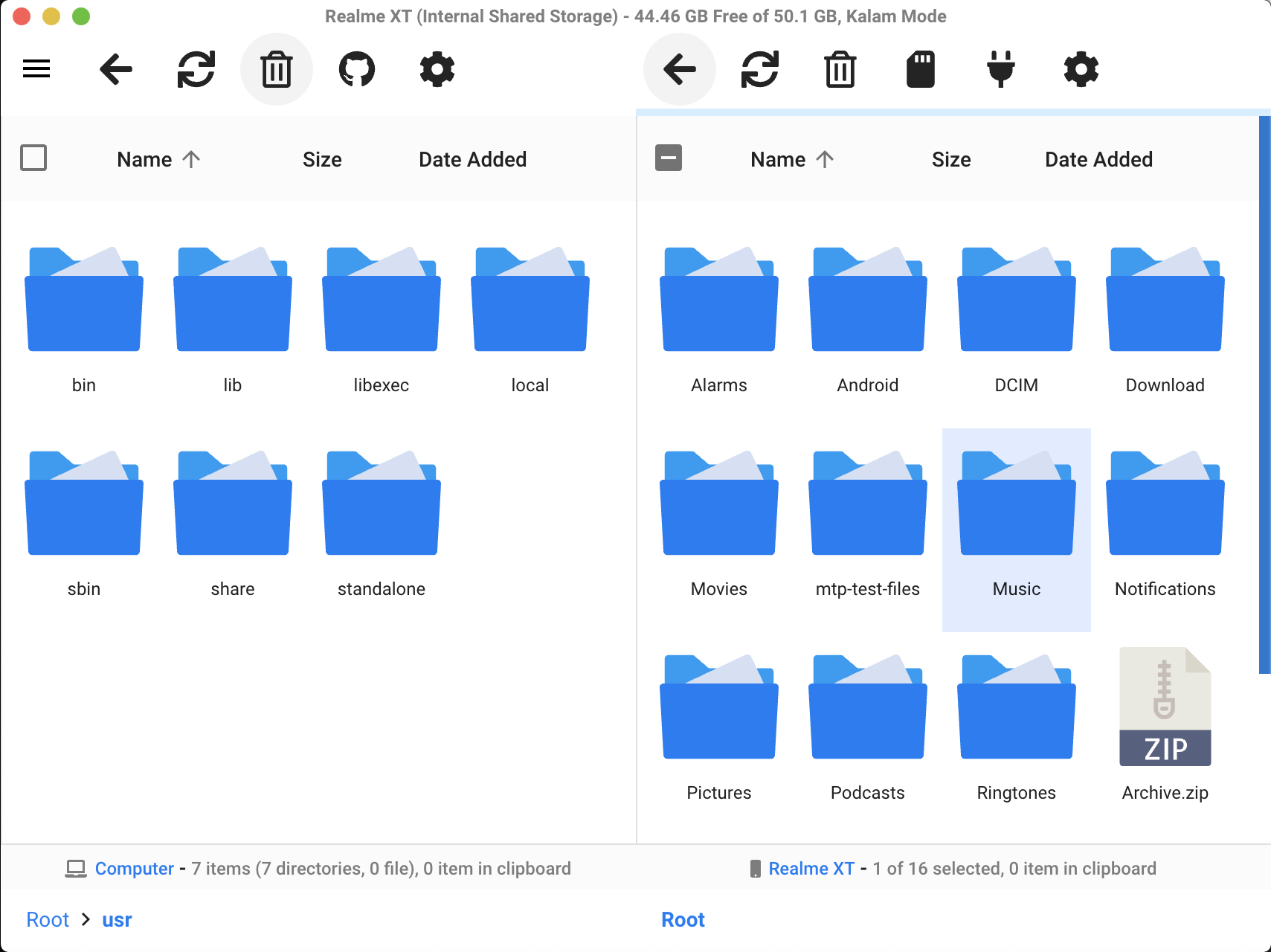
OpenMTP is another renowned option for connecting your Android to your computer. Since OpenMTP is an open-source program, it’s free to use and will benefit from frequent stability updates. Naturally, that can also be a downside since Apple and Android updates don’t always take the needs of free software into consideration, but OpenMTP will usually work correctly for your data transfer needs.
One of the primary points of interest for prospective OpenMTP users is the ability to transfer folders and multiple files at a time. Aside from that, the app boasts fast file transfer times, a few thematic customization options (such as a dark mode), and different viewing options for files and folders. If you want to use OpenMTP, do the following:
- Install OpenMTP on your Mac.
- Plug your Android into your Mac using the USB cable that came with the device.
- When prompted, select the “File Transfer” option on the USB pop-up on your Android’s screen. You may need to open a notification regarding “USB Charging” first.
- Open the OpenMTP app. If you don’t see your Android, click Refresh to fix the problem.
- Free and open-source
- Can be used on both Windows and Mac
- Сan efficiently handle large files
- Offers a simple and intuitive user interface
- May lack advanced features some users need
- Mostly relies on USB connections
- Some users may experience compatibility issues with some Android devices
Conclusion
OpenMTP has the distinct benefit of being a simple, relatively stable, and always-free option for casual Android and macOS combination users. If you’re comfortable with its minimal interface and open-source quirks, you should have no trouble using this app to backup files from and access files on your Android.
- macOS
- Windows
- Free
Check out Dr.Fone for Connecting Android to Mac
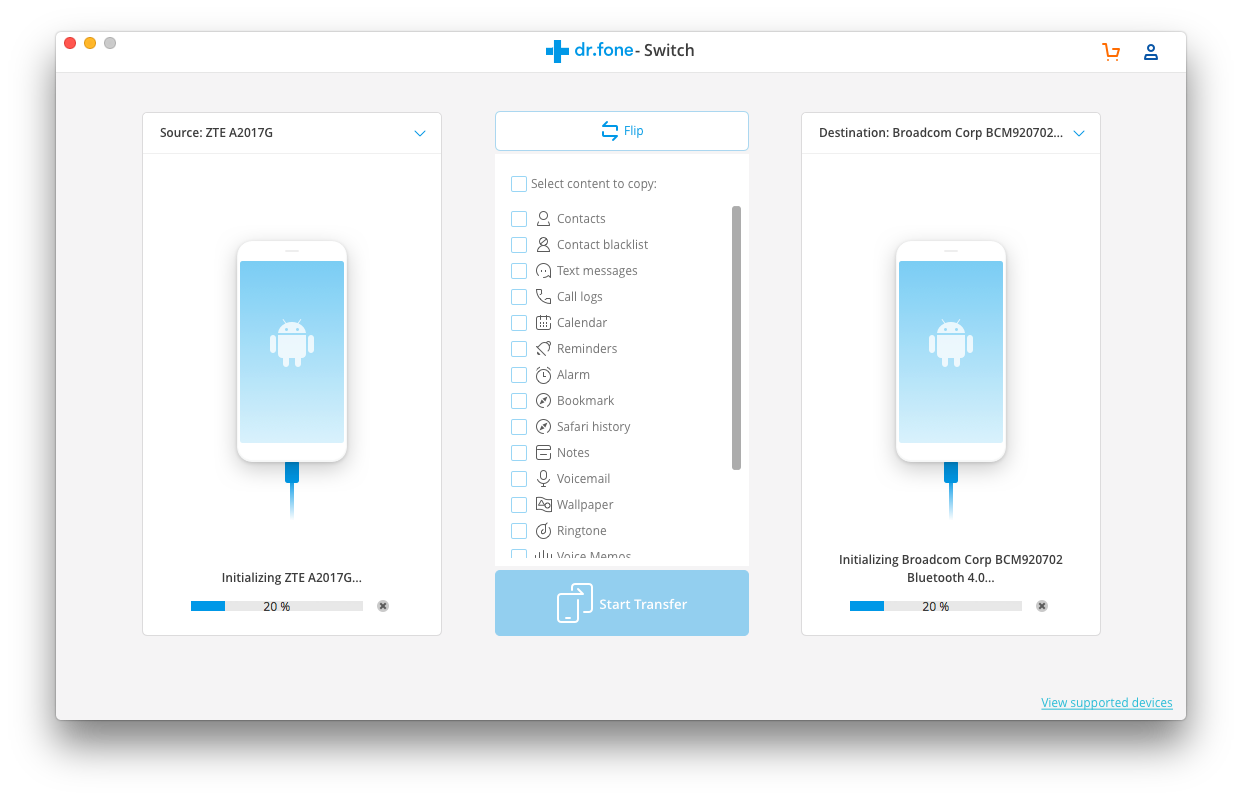
Dr.Fone is a file transfer app that, among other operating systems, covers the ability to connect your devices. This application goes above and beyond in that it can group your Android’s files by category before you ever open your Android’s file manager, making it easy to separate out photos, videos, text message files, and so on. You can also skip the organization and simply transfer all of your Android’s files onto your Mac for a quick backup, or you can use the built-in options to move things from iTunes over to your Android with the click of a button. There is even a network option to share files wirelessly, so you don’t technically have to connect Android to Mac with USB.
The main issue users will find with Dr.Fone is the price. In addition to costing a hefty $29.95 per year for use making it the most expensive app on this list by far. There is no free version past the trial period, so you’ll need to shell out if you want to use this app with any degree of longevity. Here’s how to connect your Android to your Mac with Dr.Fone:
- Download and install Dr.Fone’s desktop app on your Mac.
- Plug your Android into your Mac using the USB cable that came with the device.
- Launch Dr.Fone, then select the file transfer or view option that you want to use with your Android.
- Follow the on-screen steps to browse your files, and remember to disconnect your Android when you’re done.
- Offers a wide range of features
- Works on both Windows and Mac computers
- Offers various other tools, such as data backup, data transfer, system repair, and more
- No free version, only a free trial
- Pricey app
- Does not support old Android models
- Occasional errors in data recovery
Conclusion
There are absolutely other options available for your file transfer needs, but if you’re interested in more structured options and you can justify the price tag, Dr.Fone is a solid option for any user who wants to spend less time browsing and more time moving stuff. While its intended clientele seems more like users who service a large number of Android devices for a fee, individual users will get more than enough out of its wide range of features, making it a strong answer to folks wondering how to connect Android to Mac.
- macOS
- Windows
- $29.95 per year
Connect Android Phone to Mac using Third-Party Apps
Pair Your Android Phone with Your Mac via Bluetooth
Bluetooth allows you to pair your devices wirelessly without additional software. Follow these simple steps:
- Activate Bluetooth on Mac and Android.
- On Android phone: Settings → Bluetooth. On Mac → System Preferences → Bluetooth.
- On Macbook, in the Bluetooth menu, you’ll see your Android in the “Devices” list. Click on it to pair both devices. If necessary, enter the passcode that will appear on your Mac, on your Android phone.
- After successful pairing, you can start to transfer files between your Android phone and Mac.
- No need to install third-party apps
- Wireless connection
- Easy pairing process and simple file transfer
- Works with most modern Android devices and Macs
- Bluetooth is relatively slow compared to file transfer apps
- The Bluetooth range is limited
- Bluetooth connections can be subject to security risks
Transfer Files Between Your Devices Through Google Drive
Another easy and convenient way to connect your Android and Mac devices is through Google Drive. Using the cloud storage abilities, you can easily sync and access your files on both devices without the hassle of cables or compatibility issues. Follow these simple steps:
- Install the Google Drive app on your Mac or open web version (drive.google.com) through your browser.
- Download the Google Drive app on your Android via Google Play Store.
- Sign in to your Google account on both devices.
- And that’s it! Now you can share the files by uploading them from your phone to your drive account. Then, through the app or browser on your Mac computer, access the files and download them.
- Free Google Drive accounts have limited storage
- Requires a stable internet connection
- Possible delays in file synchronization
- Bluetooth is relatively slow compared to file transfer apps
- The Bluetooth range is limited
- Bluetooth connections can be subject to security risks
Conclusion
Finding a way to connect Android phone to Mac doesn’t have to be an arduous task. While the process isn’t perfect, using any of the third-party apps in this article as an intermediary between your phone or tablet and your Mac will almost always guarantee a smooth and simple connection that facilitates anything from file transfers and backups to remote access for your Android. You have plenty of options, but MacDroid remains our top choice due to its robust features, ease of use, and clean aesthetic; however, it’s safe to say that you won’t struggle when using any of these file transfer apps with virtually any modern Android.
